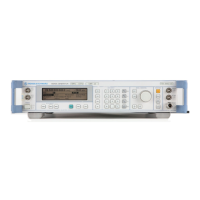R&S SMR Putting into Operation
1134.9108.12 E-1 1.1
1 Putting into Operation
This chapter contains all information about putting into operation (unpacking, connection to AC supply,
switching on and off), functional testing and installation of the instrument, preset settings and views of
the front and rear panel showing the controls and connectors needed for operation.
General Instructions
Before putting the SMR into operation, please make sure that
• the covers of the casing are put on and screwed,
• the ventilation openings are free,
• no signal voltage levels exceeding the permissible limits are applied at the inputs,
• the outputs of the instrument are not overloaded or connected incorrectly.
If these points are not observed, the instrument might be damaged.
Unpacking the Instrument
remove protective cabs
Take the instrument out of the shipping box and check whether the
items listed in the packing list and in the lists of accessories are all
included.
Remove the two protective caps from the front and rear of the SMR
and carefully check the instrument for damage.
Should the instrument be damaged, immediately notify the forwarder who shipped the instrument to you
and keep the box and packing material.
For further transport or shipment of the SMR the original packing should also be used. It is
recommended to keep at least the two protective caps for front and rear side in order to prevent
damage to the controls and connectors.
Setting up the Instrument
For applications in the laboratory or on a work bench, it is recommended that the support feet on the
bottom of the instrument be extended. For the LCD display, this provides the optimum viewing angle
which typically ranges from perpendicular to the display front to approximately 30° below.
WARNING
The feet must be fully folded in or out. Only in this way can the stability of SML be
guaranteed and reliable operation be ensured. With the feet out, the weight of other
units put onto SML must not exceed 30 kg. The units must be secured against
slipping (eg by locking the feet of the unit at the top side of the enclosure).
When shifting the unit with the feet out, the feet might collapse and fold in. To avoid
injuries, the unit must therefore not be shifted with the feet out.

